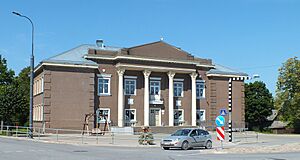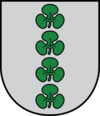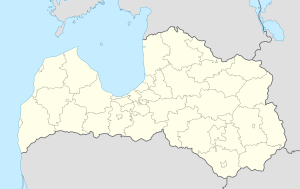Kārsava facts for kids
Quick facts for kids
Kārsava
|
||
|---|---|---|
|
Town
|
||

Cultural centre in Kārsava
|
||
|
||
| Country | ||
| Municipality | Ludza Municipality | |
| Town rights | 1928 | |
| Area | ||
| • Total | Lua error in Module:Wd at line 1,575: attempt to index field 'wikibase' (a nil value). km2 (Formatting error: invalid input when rounding sq mi) | |
| • Land | Lua error in Module:Wd at line 1,575: attempt to index field 'wikibase' (a nil value). km2 (Formatting error: invalid input when rounding sq mi) | |
| • Water | Expression error: Unexpected < operator. km2 (Formatting error: invalid input when rounding sq mi) | |
| Population
(2024)
|
||
| • Total | 1,843 | |
| Time zone | UTC+2 (EET) | |
| • Summer (DST) | UTC+3 (EEST) | |
| Postal code |
LV-5717
|
|
| Calling code | +371 657 | |
| Website | http://www.karsava.lv/ | |
Kārsava is a small town in Latvia. It is located in the Latgale region, close to the border with Russia. Kārsava is part of the Ludza Municipality.
Contents
History of Kārsava
Early Settlers
The area around Kārsava has been home to people for a very long time. An ancient Baltic tribe called the Latgalians lived here as far back as the 8th century. You can still find several hillforts near the town. These were like old forts built on hills for protection.
Growth and Development
In 1763, a Catholic church was built in Kārsava. This was an important step for the community. The town grew because it was on a major postal road. This road connected important cities like Rēzekne and Ostrov.
Kārsava grew even faster when a railway line was built nearby. This railway connected St. Petersburg and Vilnius. Because of the railway, Kārsava became a busy place for trade. Goods could be easily moved in and out of the town.
Kārsava During World War II
Before World War II, in 1935, Kārsava had a population of 2,181 people. About 37% of these residents were Jewish. During the war, many Jewish people in Kārsava were tragically killed. This terrible event is known as the Holocaust.
Kārsava Today
Today, Kārsava is a quiet town in eastern Latvia. It continues to be a local center for the surrounding area. The town has a cultural center, which you can see in the picture. This center is a place where people gather for events and activities.
See also
 In Spanish: Kārsava para niños
In Spanish: Kārsava para niños



